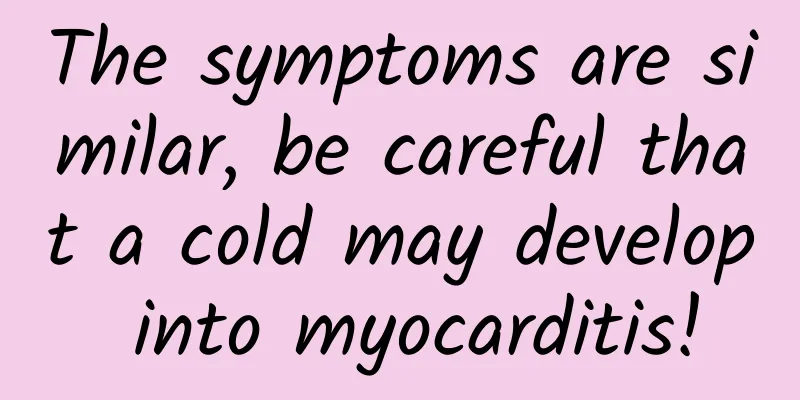The symptoms are similar, be careful that a cold may develop into myocarditis!

|
Review expert: Peng Guoqiu, deputy chief physician of the Fourth Medical Center of the General Hospital of the Chinese People's Liberation Army Winter is the peak season for colds, and many people will get sick if they are not careful. But how can a cold turn into myocarditis? What is the connection between them? Colds and myocarditis The cold is a common respiratory disease, usually caused by a viral infection. Symptoms include nasal congestion, sneezing, runny nose, fever, cough, headache, general discomfort, etc. In most cases, it can heal on its own. Myocarditis refers to a disease in which the myocardium has localized or diffuse inflammation, usually caused by viral infection, but may also be caused by bacterial infection, drug reaction, autoimmune disease, etc. Some pathogens of colds, such as coxsackievirus, cytomegalovirus, influenza virus, parainfluenza virus, etc., are also pathogens that induce viral myocarditis or myocardial damage. Its symptoms vary in severity and may include fever, fatigue, chest tightness, palpitations, etc., and may also lead to heart dysfunction, arrhythmia, and damage to the liver, kidneys, brain and other organs. Symptoms are similar, but different The symptoms of myocarditis are similar to those of a common cold, but never mistake myocarditis for a common cold. The symptoms of myocarditis vary in severity. Usually, the symptoms of a cold are cough, runny nose, sore throat, fever, general discomfort, etc., which are very similar to the symptoms of myocarditis. However, a cold is generally not accompanied by serious heart symptoms, while myocarditis, in addition to the above symptoms, may also cause palpitations, chest tightness, chest pain, shortness of breath after activity, difficulty breathing, fatigue, etc. In severe cases, there may even be life-threatening complications such as arrhythmia and heart failure. Beware of colds that may develop into myocarditis It is not uncommon for a cold to develop into myocarditis. Data show that more than half of patients with viral myocarditis have had a cold before the onset of the disease. The early stages of myocarditis often present with symptoms of upper respiratory tract infection or intestinal infection. The characteristic symptoms of myocarditis, such as chest tightness, palpitations, extreme fatigue, and sweating, appear 7 to 10 days after the onset of the disease. For patients with colds, if they experience persistent discomfort or heart-related symptoms, they should see a doctor as soon as possible so that myocarditis can be detected and treated in time. Fulminant myocarditis Myocarditis can be chronic, acute, or fulminant, with fulminant myocarditis being the most serious. Fulminant myocarditis is also called acute severe viral myocarditis. Its main characteristics are rapid onset and rapid progression, which can lead to cardiogenic shock and even sudden death. In the early stage, fulminant myocarditis is very hidden and can be easily mistaken for a cold. Patients will soon develop heart failure or severe arrhythmia, and may be accompanied by multiple organ failure such as lung, liver, and kidney. How to prevent myocarditis 1. Prevent infection and avoid contact with infection sources as much as possible: Most myocarditis is caused by viral infection, so attention should be paid to preventing respiratory and intestinal infections. During the epidemic period of acute upper respiratory tract infection, try to avoid places where people gather. Wear a mask when going out and ventilate the room every day. In addition, try to avoid contact with known infectious patients to reduce the chance of infection. 2. Improve your physical fitness and avoid overwork: Develop good living habits, regular work and rest schedules, and exercise appropriately to improve your body's immunity. Overwork can weaken the immune system and increase the risk of infection, so you should arrange your work and rest time reasonably. 3. Get vaccinated to prevent colds: If conditions permit, get a flu shot to prevent the flu. 4. Adjust your mentality and maintain physical and mental health: Maintaining a good mental state and avoiding long-term tension and stress will help maintain the function of the immune system and reduce the risk of disease. 5. Maintain good eating habits: Properly match nutrition, maintain a balanced and regular diet, avoid high-fat, high-sugar and high-salt foods, reduce the burden on the heart, and enhance the body's resistance. 6. Regular check-ups and timely treatment: For people who have already suffered from myocarditis, regular heart examinations are required to detect and treat changes in the condition in a timely manner. 7. Rest more after catching a cold and exercise with caution: Patients who have caught a cold should try to avoid excessive physical activity, including physical labor and sports, within two weeks. |
Recommend
Liu Weidong's Operation Notes | Learn content operations from Sohu
text Before writing, I would like to share with y...
Analysis of private domain traffic operation system!
What is private domain traffic ? How to operate p...
How to write a good event planning proposal?
I have seen many excellent activity plans, but th...
The iOS version of WeChat quietly launched the "Tap Tap" function. Netizens: No need to send "Are you there?" anymore
Recently, the iOS version of WeChat was upgraded ...
Can you drink tea and brush your teeth after a meal? Huaxi doctors: These 10 things are really not recommended to do after a meal!
“The essence of walking is actually to relax your...
New Android virus: Can root any phone and cannot be deleted
[[155228]] Beijing time, November 6th morning new...
Sichuan and Chongqing dialects dominate the nation's laughter
Loading long image... Source: National Geographic...
Ten days after the Android vulnerability broke out, it changed Google and Samsung
[[144480]] Ten days after the Stagefright vulnera...
ASO promotion tips: Do not abuse keywords in app titles and descriptions
App Store Optimization (ASO) is a set of techniqu...
Coughing non-stop, use cough patch? Beware of chemical burns
Audit expert: Peng Guoqiu Deputy Chief Physician,...
How to express your love on Chinese Valentine's Day in 2020? A complete guide to express your love on Chinese Valentine's Day
The annual Chinese Valentine's Day is coming....
Where has the time gone? The classic software that was popular in those years
Time is a butcher's knife, it turns grapes pu...
Why was the tiger talisman used to mobilize millions of troops in ancient times in the shape of a tiger? Why can it only be stolen and not forged?
On the eve of the Chinese New Year of the Tiger, ...
In the tenth year, what choice did Gudong make?
[51CTO.com original article] The launch of the fi...









